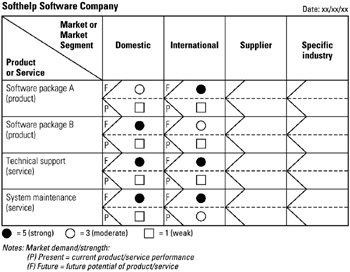Tool 36: Comparison Matrix
| AKA | Comparative Assessment Matrix |
| Classification | Evaluating/Selecting (ES) |
Tool description
A comparison matrix assists with the analysis process to identify existing gaps between an organization and its competitors, to determine the profitability potential of a product or service, or to discover other problems that may require immediate attention. When gaps, problems and profitability potential are known, a company can more effectively position its future products and services.
Typical application
-
To identify problem areas and areas where resources should best be allocated.
-
To compare organizational capability with that of competitors.
-
To perform market demand futuring for products and services.
Problem-solving phase
| → | Select and define problem or opportunity |
| Identify and analyze causes or potential change | |
| → | Develop and plan possible solutions or change |
| Implement and evaluate solution or change | |
| → | Measure and report solution or change results |
| Recognize and reward team efforts |
Typically used by
| Research/statistics | |
| Creativity/innovation | |
| Engineering | |
| Project management | |
| Manufacturing | |
| 1 | Marketing/sales |
| Administration/documentation | |
| 2 | Servicing/support |
| 3 | Customer/quality metrics |
| 4 | Change management |
before
-
Data Collections Strategy
-
Benchmarking
-
Conjoint Analysis
-
Information Needs Analysis
-
Customer-First-Questions (CFQ)
after
-
Resource Requirements Matrix
-
Opportunity Analysis
-
Gap Analysis
-
Starbursting
-
Action Plan
Notes and key points
-
A rating system of non-numeric symbols can be used in place of numeric values or non-numeric ratings. Optional: • = 5 (strong); ○ = 3 (moderate); □ = 1 (weak).
Step-by-step procedure
-
STEP 1 A facilitated cross-functional team decides upon a data-collection strategy to gather historical and forecasted information about the products/services.
-
STEP 2 The team identifies core productions/services and lists them in order of importance or value to the organization. See example Softhelp Software Company.
-
STEP 3 Appropriate markets or market segments are agreed upon.
-
STEP 4 The team selects a rating system.
-
Note: Non-numeric figures can be used in place of numeric values or non-numeric ratings.
-
STEP 5 Data is collected and discussed, and findings are plotted on the comparison matrix as shown in the example.
-
STEP 6 The team reviews the completed matrix and writes a short rationale for each product/service rating.
-
STEP 7 A final report, which describes potential, leverage points, future requirements, etc., is written and attached to the comparison matrix and submitted to management.
Example of tool application

EAN: 2147483647
Pages: 326